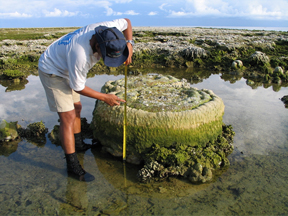Geotimes

Untitled Document

News Notes
Tectonics
Measuring the Sumatra quake
The motions on the fault that set off the Dec. 26, 2004, earthquake that sent
a tsunami across the Indian Ocean continue to puzzle seismologists.
 As part of continued examination of
the region and its potential to have another large earthquake, a team of scientists
led by Jean-Philippe Avouac of Caltech in Pasadena, Calif., looked at measurements
from before and after the 2004 Sumatra event. The data came from a network of
GPS stations across the Sunda thrust fault, where the Indian and Australian
plates meet and dive beneath the Eurasian plate.
As part of continued examination of
the region and its potential to have another large earthquake, a team of scientists
led by Jean-Philippe Avouac of Caltech in Pasadena, Calif., looked at measurements
from before and after the 2004 Sumatra event. The data came from a network of
GPS stations across the Sunda thrust fault, where the Indian and Australian
plates meet and dive beneath the Eurasian plate.
The flat top of this coral marks the
highest tides from its past, when the land beneath the corals was low enough
to keep them underwater, and the waterline marks the high tide after the Dec.
26, 2004, Sumatra earthquake. Photo is by J. Galetzka.
Part of the ground movements they documented came from measurements of the elevation
of corals, the flat tops of which mark the last time the land beneath the corals
was low enough so as to keep them underwater during high tides. The tidewater
lines mark how much previous tectonic events have pushed up or sunk the corals.
Taking all of their data together, Avouac and colleagues report in the March
2 Nature that the fault slipped as much as 20 to 30 meters in the first
few minutes of the magnitude-9-plus earthquake — and continued to slip
an estimated 30 percent more during the weeks that followed, which came as a
surprise. Their measurements have implications for where the fault is “stuck,”
where it might move again, and how it has moved and continues to move deep in
the crust. All of these factors should help scientists figure out the likelihood
of a large earthquake on the portions of the subduction fault that lie to the
south, which did not break in the 2004 event.
“The results show that we have much to learn about how deformation is
accommodated across these zones of dramatic plate convergence,” wrote Charles
Ammon of Pennsylvania State University in University Park, in a comment accompanying
the Nature paper. Ammon noted that many questions still remain, including
why the fault ruptured again on March 28, 2005, in a magnitude-8.7 earthquake,
why the rupture in the first large event petered out to the north, and whether
more earthquakes are in store for the southern section of the fault.
Naomi Lubick
Links:
"Sumatra
quake stronger than thought," Geotimes, April 2005
"Sumatra seismic risk,"
Geotimes online, Web Extra, March 28, 2005
Back to top
Untitled Document

 As part of continued examination of
the region and its potential to have another large earthquake, a team of scientists
led by Jean-Philippe Avouac of Caltech in Pasadena, Calif., looked at measurements
from before and after the 2004 Sumatra event. The data came from a network of
GPS stations across the Sunda thrust fault, where the Indian and Australian
plates meet and dive beneath the Eurasian plate.
As part of continued examination of
the region and its potential to have another large earthquake, a team of scientists
led by Jean-Philippe Avouac of Caltech in Pasadena, Calif., looked at measurements
from before and after the 2004 Sumatra event. The data came from a network of
GPS stations across the Sunda thrust fault, where the Indian and Australian
plates meet and dive beneath the Eurasian plate.
